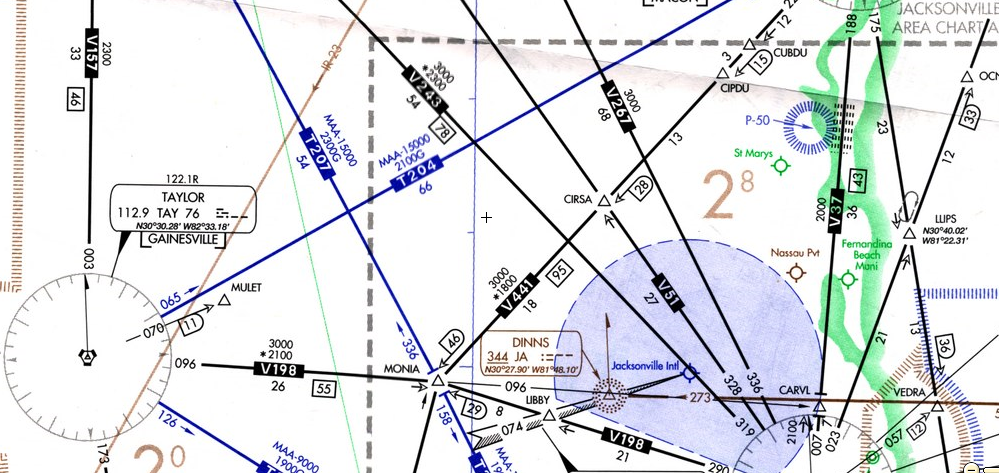Why does a T-route have a MAA?
I love getting questions from readers and my favorite questions are the ones I don’t already know. Such as the question I received lately from Jon regarding the max altitude on Tango routes:
Hi Paul. I’ve always wondered. On the Jacksonville sectional here in Florida we got a few T-Airways where the MAA is 15 000 feet. Now, the only reason I know of for a MAA restriction on an airway is because you can get several VORs on the same frequency etc, however, since this is a GPS airway, I don’t understand why an MAA would exist. Any ideas?
Well, this took a little digging but I found the answer! The first thing we need to do is understand why T-routes (pronounced “tango routes”) were established and how they help you.
Tango routes were established by the FAA at the request of AOPA in order to help pilots navigate around or through busy terminal areas. RNAV (GPS) was utilized because using ground based NAVAIDS for these routes would have resulted in some seriously inefficient flying. The FAA used RNAV to develop a point-to-point low altitude route system and designated this route structure, Tango Routes. Tango routes enable the GPS equipped pilot to efficiently fly around or through busy terminal Class B and C areas. They also help to reduce controller workload by being able to assign these routes to appropriately equipped pilots instead of having to provide manually intensive radar vectoring. Here is an example of a t-route from an enroute chart (graphics courtsey of skyvector.com)
So now to answer our question, why do T-routes have a Maximum Authorized Altitude (MAA)? The reason is not because of radio reception or being able to get multiple frequencies but because of the airspace and the agency that controls the airspace above the route.
For instance, let’s take a look at our example from above. In this case our MAA is 15,000 feet. Why?
Well, it might be for a couple reasons:
1) A T-route by definition in a low-altitude route. It is designed to assist those pilots who are flying in some busy terminal areas who wish to stay out of the way.
2) The controlling agency above. Because Tango routes are primarily terminal (in that they don’t involve the ARTCC centers) it might be that Jacksonville Center starts at 16,000 feet and in order to provide seperation to the airliner traffic above they limit the MAA on the T-route to 15,000.
3) The airspace above. T-routes can also be designed to keep pilots out of a Class B airspace. While that may not be the reason in our example, this can also be a limiting factor for the MAA on a T-route.
The important thing to remember is that to fly a t-route you will have to have an instrument rating, on a instrument flight plan and be IFR GPS equipped. With all that control, all you really have to worry about is maintaining your assigned altitude.
One other thing to notice on a T-route is that because it is not dependent on receiveing traditional line-of-sight radio signals the MEA or Minimum Enroute Altitude is a lot lower. The lower MEAs can be a significant benefit in route planning and avoidance of icing to keep you below the freezing level.
I hope this helps Jon and whether you are flying a V route, J route, Q route, Y route, or T route remember to…
Fly Safe!




Recent Links Tagged With "route" - JabberTags on Nov 10, 2008
[…] public links >> route Why does a T-route have a MAA? Saved by nytel on Sun 09-11-2008 August 28th: What’s that smell? Saved by enochchoi on Tue […]
Bob McDonald on Jun 29, 2009
Great def. of a “T” route! Thank you.I’m a 7000 hr II and have a lot of Q’s pertaining to GPS ops.Hope you’re available. It’s so great to find a reliable source of information one can trust………….
There’s so much misinformation these days.
Dick Welsh on Jun 18, 2012
I have been flying for 45 years and was planning a trip to Alaska and noticed lots of “T” routes that I had not encountered before. Thanks for the help.
Brian Hall on Nov 16, 2012
Paul, your answer may have once been valid, however. Denver ARTCC and associated en route low maps around RAP/RCA now utilize these Tango routes. I suspect with VORs being decomissioned, we shall see many more of these. Anyone can fly any route, they would have to be on an IFR flight plan with a clearance however, to do this IFR.
Brian (retired ATCS ZDV and CFI)
Brian Beckwith on Nov 07, 2023
I’m an ARTCC ATC instructor for Anchorage Center, with over 30 years experience as a controller. T-route usage is very minimal in Alaska, and until recently controllers could not assign them without the pilot filing or asking for them. There are also special equipment requirements for using T-routes in Alaska–here’s a copy&paste from the AIM you can look up: NOTE-
“Aircraft in Alaska may only operate on GNSS T-routes with GPS/WAAS (TSO-C145 (as revised) or TSO-C146 (as revised)) equipment.”